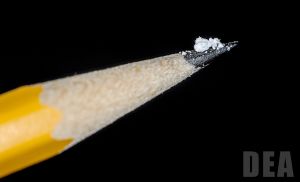Opioid toxicity
(Redirected from Heroin)
Background
- Natural derivatives: Heroin, Morphine, Codeine, Hydrocodone, Oxycodone (+ UDS)
- Synthetic: Fentanyl, Hydromorphone, Buprenorphine, Methadone, Meperidine, Dextromethorphan (- UDS)
- Obtain acetaminophen levels in all cases of combination opioid-acetaminophen (Percocet) overdoses
- Respiratory depression is the cause of all mortality from opioid toxicity
- When prescribing opioid pain relievers in the ED, remember to have a discussion of co-ingestion of other depressants (alcohol involved in 1/5 of opioid related deaths)[1]
- Consider contributing to the DAWN database for public ED research benefit (Drug Abuse Warning Network)
- Other than common co-ingestions, consider adulterants such as amphetamines, anticholinergics, hypnotics, heavy metals, etc.
- In the year after an ED visit for an opioid overdose, greater than 5% die & greater than 19% will experience another opioid overdose. [2]
Clinical Features
Common
- Miosis
- Nausea/vomiting
- Respiratory depression
- Mental status depression
Uncommon
- QT prolongation (methadone)
- Seizure (tramadol)
- Acute lung injury
- Bowel obstruction, rupture (body packers)
- Noncardiogenic pulmonary edema (1-2% of heroin overdoses)[3]
- Within 2-4 hrs of overdose
- Increased RR, cough, pink frothy sputum, CXR with bilateral infiltrates
- Resolves in 24-48 hrs with respiratory supportive care
Differential Diagnosis
- Clonidine toxicity
- Organophosphate toxicity
- CO poisoning
- Hypoglycemia
- Postictal state
- CVA - pontine hemorrhage (miosis, coma)
- ARDS
- DKA, hyperosmolar coma
- Phencyclidine toxicity
- Phenothiazine toxicity
Sedative/hypnotic toxicity
- Absinthe
- Barbiturates
- Benzodiazepines
- Chloral hydrate
- Gamma hydroxybutyrate (GHB)
- Baclofen toxicity
- Opioids
- Toxic alcohols
- Xylazine toxicity
Evaluation
- Typically clinical
- Consider Utox
Management
Airway protection and ventilatory management
- BVM and naloxone administration may prevent need for intubation
Naloxone (Narcan)
May repeat Naloxone q3min up to max dose 10mg. It has an almost immediate onset of action with a duration of action = 20-90min (depending on the drug ingested, most overdoses especially from heroin will require repeat dosing of Naloxone)
Dosing
- If apneic or near-apneic - 2mg IV
- If opioid-naive with minimal respiratory depression - 0.4mg IV
- If opioid-dependent with minimal respiratory depression - 0.05mg IV ("push dose Narcan")
- Infusion
- Only give if patient responded to the bolus and requiring repeat administration
- Step 1: Determine the "wake-up dose" or bolus required to wake the patient
- Step 2: Give 2/3 of the "wake-up dose" per hr; mix in 1L D5W
GI decontamination
- Activated charcoal x1 if opioid ingestion occurred within 1hr
Disposition
Heroin intoxication
- Can consider discharge 1-2hr[4] after naloxone administration if all are true:
- Ambulatory without assistance
- O2 sat >92% (room air)
- RR >10bpm
- HR >50
- Normal temp
- GCS 15
Non-heroin intoxication
- Consider discharge after 4-6hr observation
- Methadone toxicity: observe for 12-24hr (longer half-life)
Narcan Prescription
- Many states (31) offer protection again criminal liability for prescribing and distributing naloxone to laypeople
- A new California law requires providers to offer Naloxone autoinjector prescriptions to certain patients at risk for overdose
| Manufacturer | Route and Dose | Cost/Dose |
|---|---|---|
| Adapt Pharma | Prefilled IN 4mg | $33 |
| Amphastar | Self-assemble IN 2mg | $33 |
| Hospira | Self-assemble IM 0.4mg | $15.83 |
| Kaleo | Autoinjector 0.4mg | $287.50 |
- Example Prescription
- Naloxone 4mg/0.1mL prefilled syringe and intranasal atomizer device
- Deliver 1 spray to nostril upon signs of opioid overdose. May repeat X 1. Call 911.
Indications[5]
- Discharged from the ED after opioid intoxication or poisoning
- Receiving high doses of opioids or undergoing chronic pain management
- Receiving rotating opioid medication regimens
- Having a legitimate need for analgesia combined with a history of substance abuse
- Using extended/long-acting opioid preparations
- Completing mandatory opioid detoxification or abstinence programs
- Recent release from incarceration and past abuser of opioids
See Also
External Links
- MDCalc - Opioid Risk Tool (ORT) for Narcotic Abuse
- Narcan autoinjection instructions (English)
- Narcan autoinjection instructions (Spanish)
References
- ↑ Jones CM, Paulozzi LJ, Mack KA. Alcohol Involvement in Opioid Pain Reliever and Benzodiazepine Drug Abuse–Related Emergency Department Visits and Drug-Related Deaths — United States, 2010. CDC MMWR. October 10, 2014 / 63(40);881-885.
- ↑ Davis, C., Carr, D., Glenn, M., & Samuels, E. (2021). Legal Authority for Emergency Medical Services to Increase Access to Buprenorphine Treatment for Opioid Use Disorder. Annals of Emergency Medicine, 78(1), 102–107.
- ↑ Sporer KA and Dorn E. Heroin-related noncardiogenic pulmonary edema: a case series. Chest. 2001; 120(5):1628-32.
- ↑ Willman MW, Liss DB, Schwarz ES, and Mullins ME. Do heroin overdose patients require observation after receiving naloxone? Clin Toxicol (Phila). 2016; Nov 16:1-7.
- ↑ ACEP Policy Statement. "Naloxone Prescriptions by Emergency Physicians." Approved by ACEP Board of Directors October 29, 2015.



